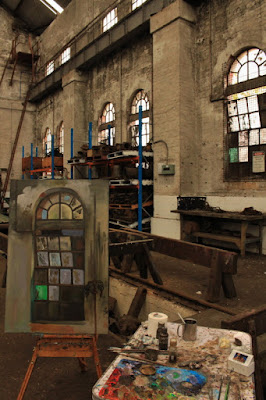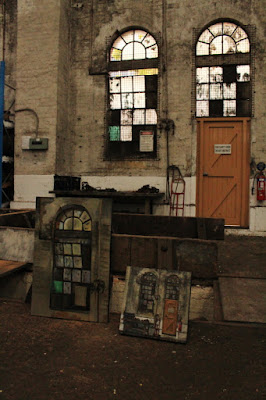I took advantage an almost deserted CBD during a public holiday, to record some of the buildings in Castlereagh St that will soon be demolished to make way for new metro stations around Martin Place.
 |
| Painting 'Panorama of Castlereagh st, from Hunter st to Martin Place' 2017 oil on canvas 31 x 103cm |
Enquiries : janecooperbennett@gmail.com
I took a panoramic canvas to try to squeeze in as much of the streetscape as possible.
On this canvas I've managed to get the lovely Art Deco building on the north corner of Hunter and Castlereagh St, 55 Hunter St, 10 - 12 Castlereagh st and a doorway of the lovely old Commonwealth Bank building that now houses Macquarie Bank.
 |
| Painting 'Panorama of Castlereagh st, from Hunter st to Martin Place' 2017 oil on canvas 31 x 103cm |
Enquiries : janecooperbennett@gmail.com
Ironically there is a keystone in the Macquarie Bank building that was placed there by the controversial NSW premier Jack Lang, who once attempted to nationalize the banks and cancel Australia's war debts to the UK. I can't help wondering what Jack Lang would have thought of Macquarie Bank!
 |
| Painting 'Panorama of Castlereagh st, from Hunter st to Martin Place' 2017 oil on canvas 31 x 103cm |
Enquiries : janecooperbennett@gmail.com
Several skateboarders and parkour experts can just be seen in the distance, grouped
on the stairs of the soon to be demolished 17 storey building at 55
Hunter street. Unfortunately I had to break the news to them that their favourite ramps and railings at 55 Hunter St where they practise their jumps will soon be demolished. They will make the most of their unofficial skate park until it is knocked down next month, and entertained me with over 2 hours of death defying jumps, twists and somersaults.
 |
| Painting 'Panorama of Castlereagh st, from Hunter st to Martin Place' 2017 oil on canvas 31 x 103cm |
Enquiries : janecooperbennett@gmail.com
There seems to be something about this street corner that attracts larrikins, past and present.
A trio of slightly less acrobatic larrikins of the past, also used this unassuming corner of the CBD to rattle the cage of conservative society over 50 years ago.
A famous copper sculpture by Tom Bass, bites into the Hunter street facade of this office block. It had been commissioned by P&O as a wall fountain in 1961, and was intended to be seen as a purely abstract design.
However, when this work was unveiled, its indirect resemblance to a Parisian pissoir and its position opposite the French Airline Office, led to a notorious lampoon in the 6th edition of Oz magazine. The editors of Oz magazine, Richard Neville, Richard Walsh and Martin Sharp, were charged, tried and sentenced to jail with hard labour for "obscenity and encouraging public urination", although the defendants subsequently appealed against the sentences, which were revoked.
 |
| Painting 'Panorama of Castlereagh st, from Hunter st to Martin Place' 2017 oil on canvas 31 x 103cm |
Enquiries : janecooperbennett@gmail.com
Tom Bass wasn't offended by the Oz magazine send up of his sculpture, and actually appeared in the trial for the defendants.
 |
| Painting 'Panorama of Castlereagh st, from Hunter st to Martin Place' 2017 oil on canvas 31 x 103cm |
Enquiries : janecooperbennett@gmail.com
Through the Chifley arcade are a couple of other buildings due for demolition, 5-7 Elizabeth street. 7 Elizabeth street is an elegant art-deco apartment block, recently vacated by its reluctant ex-residents.
























